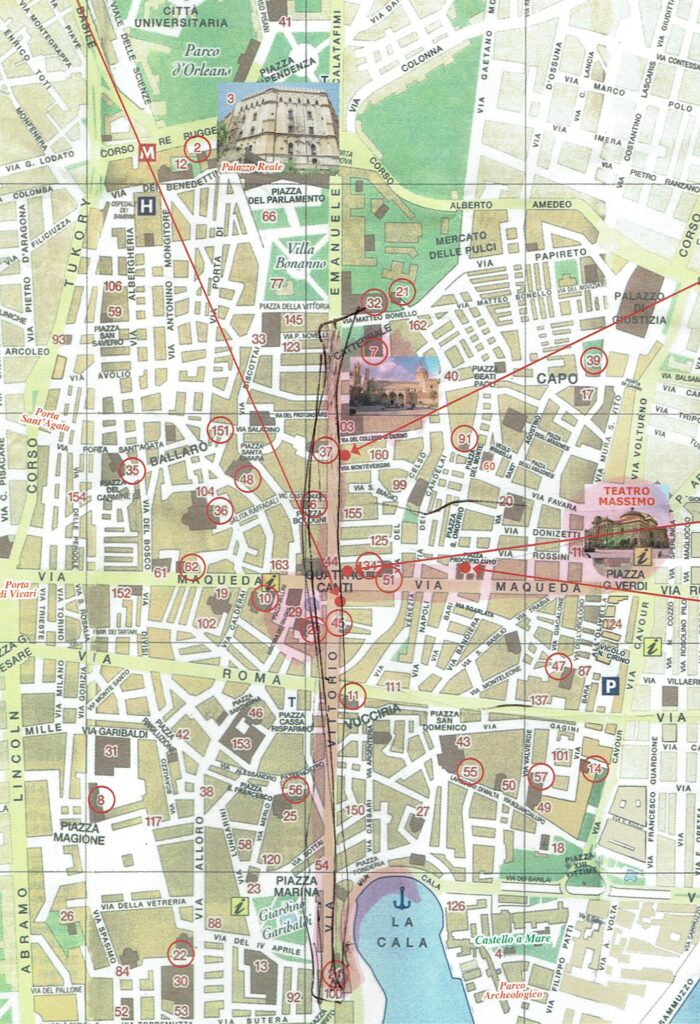Between Eastern Med and Western Med routes, Palermo sits at the foot of Monte Pellegrino at the heart of a large natural harbour, offering a complex history.
The title of Capital of Culture is well deserved because it has hosted dozens of civilisations: Arab, Greek, Roman, Norman, Carthaginians, Goths, the Byzantine Empire, and even the Spanish have a footprint in the architectural mix.
Whilst there is more than enough to do for a long stay, there are some obvious must-see attractions that the day visitor will probably aim for. Jean takes us around a few key areas in this huge historic city. Obviously, she covers the Cathedral although this is the feature of its own film. The old city gates, the No Mafia Museum next to the tourist centre, and the church with a bakery that sells beer for a rest in the garden. She finds the biggest opera house in the whole of Italy, The Teatro Massimo Vittorio Emanuele. It is located on the Piazza Verdi to the right of the main street. Markets are easy to find on the way here. Jean also walks around the Catedral museum.
The history of Palermo can be confusing as it is told in a few ways, by each of the groups. The cathedral has been a church and a mosque like so many religious buildings in the Mediterranean. The cathedral offers different tickets to include what you wish to do. Do you want the roof view, the museum, or access-all-areas? The view from the roof is a hard climb and a narrow stairway. The walk down to see the sarcophagus of the bishops in the basement also has many steps and some access is very narrow.
The Pope's agent Roger II lies on the main floor of the cathedral. The museum which can be on the same ticket offers a wealth of religious artefacts and is in adjacent buildings.
 You may be offered numerous maps and some are confusing. You can walk around the bay from your ship and join the main road and walk up it. Or you can walk into town knowing you have to head left a few blocks as you go up.
You may be offered numerous maps and some are confusing. You can walk around the bay from your ship and join the main road and walk up it. Or you can walk into town knowing you have to head left a few blocks as you go up.
Jean does not get to the macabre tourist attraction of the Capuchin Catacombs of Palermo which are burial catacombs in Palermo. Nor does she go insude the mosaic-laden Palazzo dei Normanni. The list of highlights is overwhelming, so her tour of the main events may help you plan a day that does not waste time going back and forth or detouring to places that can be left to another visit.
The list of sites is almost endless, but many have difficult access. Another which can challenge is the Castello della Zisa, listed as either a castle or palace. Located in the western area of Palermo, the edifice was begun around 1165 by Moorish craftsman. Part of the city's Arab-Norman history.
Here are three Palermo maps to consider.
For the ambitious traveller there is the tram network (see map). It was opened in 2015 and has 4 lines.
The tour bus map and the spots it visits are found by clicking the advert box to their website. Finally, the map we include below for simple walking orientation.

There's a chat group for your ship - click here to find it
A trip not on the maps is one to the village of Morreale. What makes this important is that when the Arabs took Sicily in 831, this is where the Bishop of Palermo fled to and built a church. Morreale now has one of the world’s most stunning architectural treasures: the Duomo. The small village is in the hills overlooking Palermo. It is about an hour and a half by bus 100 or 118. When the Arabs took Sicily in 831, this is where the Bishop of Palermo fled to and built a church. Then, in 1174 reconstruction was started by William II, in 1182 the church, dedicated to the Nativity of the Virgin Mary, was, by a bull of Pope Lucius III, elevated to the rank of a metropolitan cathedral. It is one of the world's ten most visited monuments.

No comments:
Post a Comment